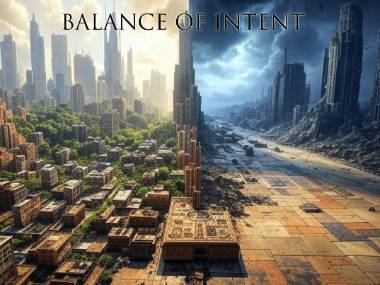Balance of Intent
Balance of Intent
Game Title
- Balance of Intent
Genre
- Strategy
- Moral Dilemma
- Simulation
Platform
- PC
- Console (PS5, Xbox Series X)
- Potential for VR expansion
Game Concept
Overview
"Balance of Intent" places players in a richly detailed world where they must choose between two factions: Benevolence and Malevolence. Each faction has its own unique objectives, mechanics, and narrative arcs. The game explores deep themes of morality, governance, and the impact of individual and collective actions on society.
Core Gameplay Mechanics
- Faction Choice:
- Benevolence:
- Objectives: Improve living conditions, promote peace, advance education, combat corruption, and mitigate environmental damage.
- Mechanics: Resource allocation for public welfare, diplomacy, education, and technology development.
- Malevolence:
- Objectives: Sow discord, corrupt institutions, trigger economic collapse, or incite conflict.
- Mechanics: Espionage, sabotage, manipulation of media, and orchestration of crises.
- Benevolence:
- Decision Points:
- Players face moral choices that significantly impact the game world. Each decision can shift the balance towards one faction or the other, affecting everything from NPC behavior to environmental changes.
- Influence System:
- Influence Points: Earned through actions that align with your faction’s goals. These points can be spent on unique abilities or events that further your cause.
- Public Opinion: A dynamic system where the populace reacts to player actions, potentially swaying support from one side to another.
- Dual Campaigns:
- Benevolence Campaign: Focus on building, with scenarios like revitalizing a city post-disaster or reforming corrupt systems.
- Malevolence Campaign: Focus on deconstruction, with missions to undermine stability or exploit societal weaknesses.
- World Simulation:
- A living world with its own economy, political tensions, and environmental conditions. Actions taken by players in one area can have ripple effects across the globe.
- Resource Management:
- Benevolence: Manage resources for societal growth, like education, health, and infrastructure.
- Malevolence: Use resources to fund covert operations, bribes, or to create chaos.
- Narrative Elements:
- Story Arcs: Each faction has its own set of characters, backstories, and goals. Players can influence these narratives through their choices.
- Multiple Endings: The endgame depends on the balance of power between the factions, leading to various outcomes from utopia to dystopia.
- Multiplayer Mode:
- Asymmetric Gameplay: Players from opposing factions can interact in the same world, with one trying to build while the other destroys, leading to strategic depth and player interaction.
Visual and Audio Aesthetics
- Art Style: A blend of realistic and stylized graphics to reflect the dichotomy between order and chaos, with environments changing based on the dominant faction's influence.
- Sound: Adaptive soundtrack that shifts tone based on the game's moral landscape, with ambient sounds reflecting the state of society.
Ethical Considerations
- Moral Ambiguity: The game does not present clear good or evil sides but rather shades of grey, challenging players to reflect on their actions.
- Content Warnings: For themes of manipulation, corruption, and societal collapse.
Development Considerations
- AI: Sophisticated AI for NPC reactions and world dynamics to respond realistically to player choices.
- Balance: Ensuring neither side feels overpowered, providing strategic depth for both preservation and destruction.
"Balance of Intent" would offer players a sandbox where the very fabric of society is at their fingertips, encouraging them to ponder the weight of their moral compass in shaping the world around them.
Keywords
balance of intent strategy moral dilemma simulation pc console vr benevolence malevolence faction choice society preservation destruction moral choices influence system public opinion resource management dual campaigns world simulation economic collapse environmental damage espionage sabotage narrative arcs multiple endings multiplayer asymmetric gameplay art style adaptive soundtrack moral ambiguity content warnings ai game balance
